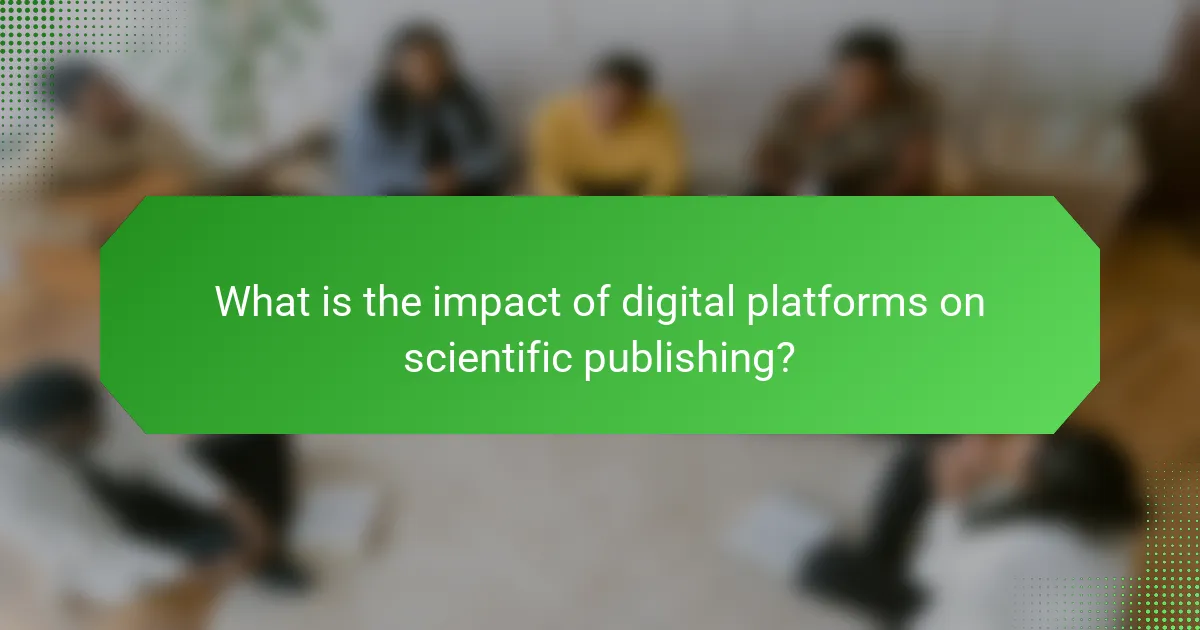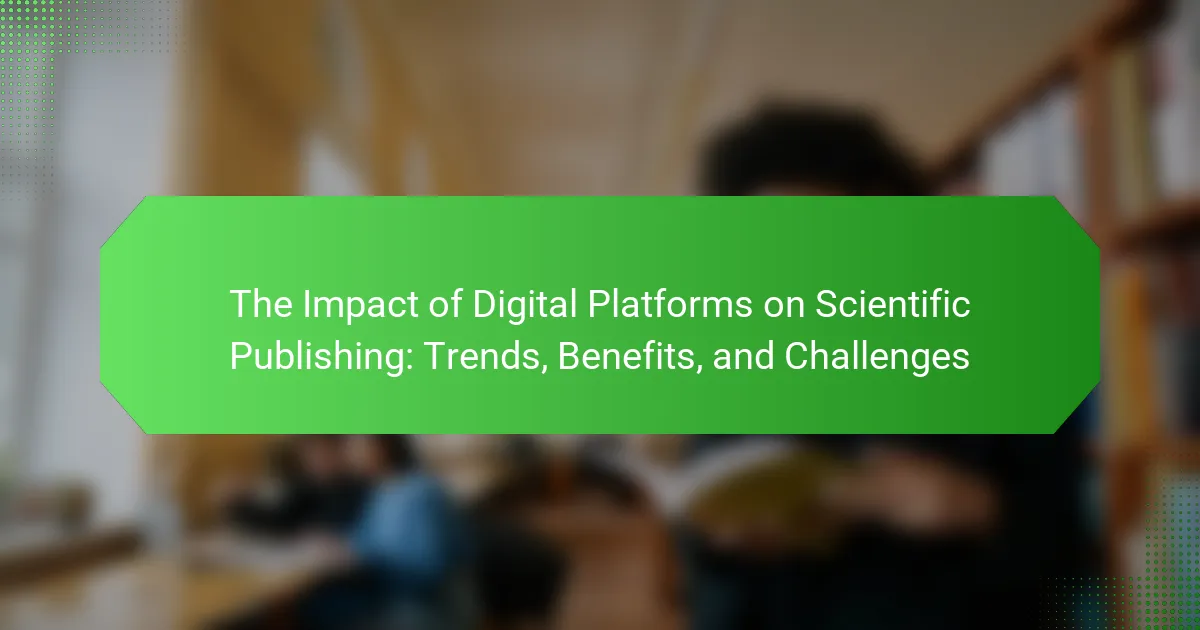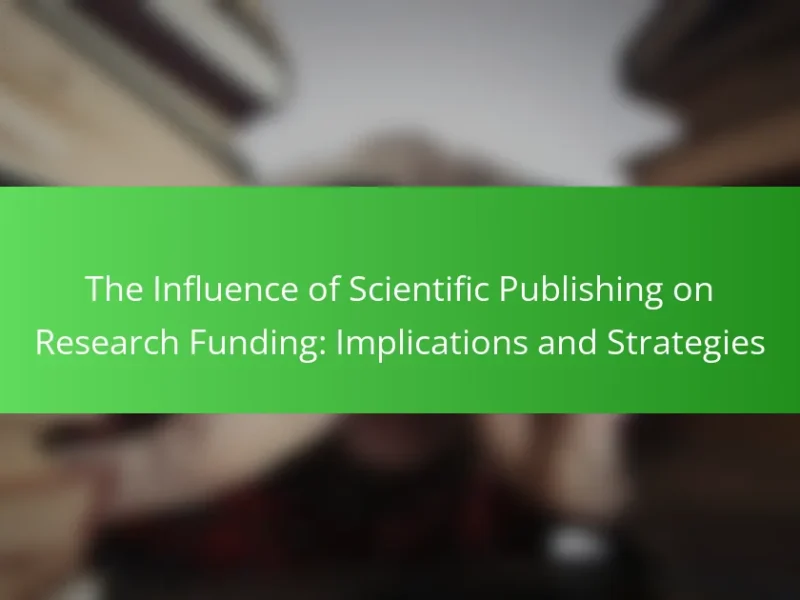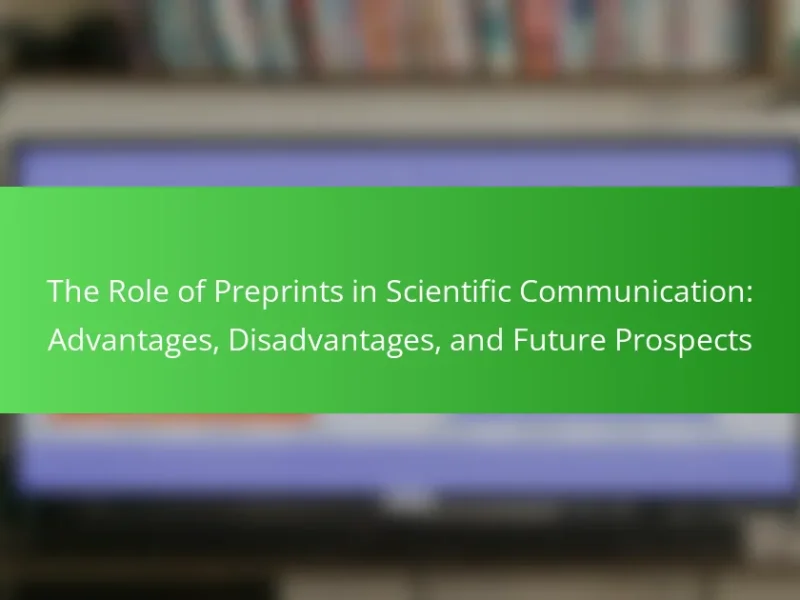Digital platforms are revolutionizing scientific publishing by enhancing accessibility and visibility for researchers. These platforms enable rapid dissemination of research findings to a global audience, with a significant preference among researchers for online sharing. Key benefits include increased collaboration among scientists across institutions and countries, as well as the promotion of open access publishing, which eliminates paywalls and broadens research distribution. This transformation has resulted in higher citation rates for online articles, marking a significant shift in the efficiency and inclusivity of scientific communication. The article will explore the trends, benefits, and challenges associated with this evolving landscape of scientific publishing.

What is the impact of digital platforms on scientific publishing?
Digital platforms significantly enhance scientific publishing by increasing accessibility and visibility. They allow researchers to disseminate their work rapidly and reach a global audience. According to a 2020 study by the National Institutes of Health, over 80% of researchers prefer online platforms for sharing findings. Digital platforms also facilitate collaboration among scientists across different institutions and countries. Furthermore, they enable open access publishing, which removes paywalls and promotes wider distribution of research. This shift has led to a rise in citation rates for articles published online. Overall, digital platforms have transformed the landscape of scientific communication, making it more efficient and inclusive.
How have digital platforms transformed the landscape of scientific publishing?
Digital platforms have significantly transformed scientific publishing by enhancing accessibility and accelerating dissemination. Researchers can now share findings instantly through online journals and preprint servers. This shift has reduced publication times from months to days. Furthermore, digital platforms allow for wider audience reach, enabling global collaboration. Open access models have emerged, providing free access to research articles. This democratizes knowledge and promotes transparency in research. Data analytics tools on these platforms help track readership and impact. The integration of multimedia elements enriches content presentation. Overall, digital platforms have revolutionized how scientific knowledge is shared and consumed.
What are the key features of digital platforms in scientific publishing?
Digital platforms in scientific publishing feature accessibility, speed, and interactivity. They allow researchers to share findings rapidly and reach a global audience. These platforms often support multimedia content, enhancing the presentation of research. They provide tools for collaboration among scientists, facilitating joint projects. Additionally, digital platforms enable data sharing and open access, promoting transparency. They often include metrics for tracking engagement and impact. Many platforms also offer advanced search functionalities, improving discoverability of research. Finally, they can integrate with citation management tools, streamlining the research process.
How do digital platforms enhance accessibility to scientific research?
Digital platforms enhance accessibility to scientific research by providing open access to publications. They allow researchers to share their findings without traditional subscription barriers. This increases the visibility of research and facilitates knowledge dissemination. For instance, platforms like arXiv and ResearchGate enable free access to preprints and articles. A study by the Pew Research Center found that 87% of researchers believe open access increases the impact of their work. Additionally, digital platforms support various formats, including multimedia and interactive content, making research more engaging. They also enable global collaboration by connecting researchers across different regions. Overall, digital platforms significantly broaden access to scientific knowledge.
What trends are emerging in digital scientific publishing?
Emerging trends in digital scientific publishing include open access models, increased use of preprints, and enhanced data sharing. Open access publishing allows broader access to research without subscription barriers. According to a 2021 report by the Scholarly Publishing and Academic Resources Coalition, over 50% of new research articles are now published in open access formats. The use of preprints is rising, enabling researchers to share findings quickly before peer review. A study published in the journal PLOS Biology noted that preprints have increased by 200% in the past five years. Enhanced data sharing practices are also becoming prevalent, promoting transparency and reproducibility in research. The Open Science Framework reported a 35% increase in data sharing across various disciplines since 2019. These trends reflect a shift towards greater accessibility and collaboration in the scientific community.
How is open access publishing changing the traditional publishing model?
Open access publishing is fundamentally altering the traditional publishing model by removing subscription fees. This model allows researchers and the public to access scholarly articles without financial barriers. Traditional publishing often restricts access to those who can afford subscriptions. In contrast, open access promotes wider dissemination of knowledge. It increases visibility and citation rates for authors. According to a study published in PLOS ONE, open access articles receive 18% more citations than subscription-based articles. This shift encourages collaboration and innovation in research. As a result, funding agencies increasingly mandate open access for publicly funded research. Overall, open access publishing enhances the accessibility and impact of scientific knowledge.
What role do social media and networking play in scientific dissemination?
Social media and networking significantly enhance scientific dissemination. These platforms facilitate rapid sharing of research findings. They allow scientists to reach broader audiences beyond traditional academic circles. Social media enables real-time engagement and discussion among researchers and the public. Networking fosters collaborations, leading to increased visibility for scientific work. Studies show that articles shared on social media receive more citations. For example, a 2016 study in PLOS ONE found that tweets can predict citation counts. Overall, social media and networking play a crucial role in modern scientific communication.
What benefits do digital platforms provide to researchers and publishers?
Digital platforms offer significant benefits to researchers and publishers. They enhance accessibility to research materials, allowing for a broader audience reach. Researchers can easily share their findings with global communities. Publishers can distribute content more efficiently and at a lower cost. Digital platforms facilitate real-time collaboration among researchers, improving the speed of innovation. They also provide advanced analytics tools for tracking engagement and impact. This data helps in refining future research and publication strategies. According to a study by the International Association of Scientific, Technical, and Medical Publishers, digital platforms have increased citation rates by up to 30%.
How do digital platforms facilitate collaboration among researchers?
Digital platforms facilitate collaboration among researchers by providing tools for communication and data sharing. These platforms enable real-time messaging, video conferencing, and discussion forums. Researchers can easily share documents and datasets through cloud storage services. Collaborative writing tools allow multiple authors to work on manuscripts simultaneously. Platforms like ResearchGate and Academia.edu connect researchers with similar interests. They also provide access to a wider audience for feedback and peer review. According to a study published in the journal PLOS ONE, over 70% of researchers reported improved collaboration due to digital tools. This indicates that digital platforms significantly enhance collaborative efforts in research.
What advantages do digital platforms offer in terms of publication speed?
Digital platforms significantly enhance publication speed in scientific publishing. They enable immediate dissemination of research findings. Traditional print publishing often involves lengthy review and production cycles. Digital platforms streamline these processes through online submission and peer review systems. Research can be published in real-time, allowing for quicker access to new knowledge. According to a study by the National Institutes of Health, digital journals can reduce publication time by up to 50%. This rapid publication is crucial for timely sharing of critical discoveries, especially in fast-paced fields like medicine and technology.
What challenges do digital platforms face in scientific publishing?
Digital platforms face several challenges in scientific publishing. One major challenge is ensuring the integrity of peer review. Many platforms struggle with maintaining rigorous standards for reviewer selection and evaluation. Another challenge is combating misinformation and ensuring the quality of published research. The prevalence of predatory journals complicates the landscape, making it difficult for researchers to identify trustworthy outlets. Additionally, digital platforms often grapple with issues of accessibility and equitable access to research. Subscription models can limit access for researchers in developing countries. Lastly, the rapid pace of technological change can outstrip the ability of platforms to adapt effectively. These challenges hinder the overall effectiveness of digital platforms in advancing scientific knowledge.
How does the issue of digital divide affect access to scientific knowledge?
The digital divide significantly limits access to scientific knowledge. Individuals without reliable internet or digital devices cannot access online databases and journals. This gap creates disparities in education and research capabilities. According to the Pew Research Center, 25% of Americans lack high-speed internet access at home. Consequently, these individuals miss out on crucial scientific developments. Limited access hinders participation in scientific discourse and collaboration. This divide disproportionately affects low-income and rural communities. As a result, the overall quality of scientific literacy and innovation suffers.
What concerns exist regarding the quality and credibility of online publications?
Concerns regarding the quality and credibility of online publications include misinformation, lack of peer review, and author anonymity. Misinformation can spread rapidly online, leading to public confusion. Many online publications do not undergo rigorous peer review processes, which can compromise scientific integrity. Author anonymity may result in less accountability for published content. Additionally, the prevalence of predatory journals undermines trust in legitimate research. A study by Beall (2016) highlights the rise of such journals, which often lack transparency and quality standards. These factors collectively raise significant concerns about the reliability of information found in online publications.
How do digital platforms influence the peer review process?
Digital platforms significantly influence the peer review process by enhancing accessibility and efficiency. They facilitate faster manuscript submissions and enable real-time communication between authors and reviewers. Platforms like PubPeer and ResearchGate allow for post-publication peer review, increasing transparency. Furthermore, digital tools streamline the tracking of reviewer comments and revisions, improving the overall workflow. Studies show that online platforms can reduce review times by up to 50%. This shift has led to a more collaborative and open approach in scientific publishing.
What innovations in peer review have emerged due to digital platforms?
Innovations in peer review due to digital platforms include open peer review, automated review processes, and enhanced collaboration tools. Open peer review allows for transparency by publishing reviewer comments alongside articles. Automated review processes use algorithms to match submissions with appropriate reviewers, speeding up the review time. Enhanced collaboration tools enable real-time communication between authors and reviewers, improving feedback quality. These innovations increase accessibility and efficiency in the peer review process. Research shows that open peer review can lead to higher quality publications and greater accountability among reviewers.
How do digital platforms address issues of transparency in peer review?
Digital platforms enhance transparency in peer review through open access and public review processes. They allow researchers to view reviewer comments and editorial decisions. This visibility builds trust in the publication process. Platforms like Publons and F1000Research make peer reviews publicly available. These practices encourage accountability among reviewers and editors. Additionally, digital platforms often provide metrics on review times and acceptance rates. This data helps authors understand the review process better. Overall, the integration of transparency features fosters a more open scientific communication environment.
What future developments can we expect from digital platforms in scientific publishing?
Digital platforms in scientific publishing are expected to enhance accessibility and collaboration. These platforms will likely integrate advanced AI tools for content discovery and analysis. Real-time peer review processes may become standard, improving publication speed. Blockchain technology could ensure transparency and authenticity in research data. Increased open access models will promote wider dissemination of knowledge. Enhanced data visualization tools will aid in presenting complex research findings. Collaborative platforms may facilitate interdisciplinary research more effectively. These trends align with the growing demand for rapid and transparent scientific communication.
How might advancements in technology shape the future of scientific communication?
Advancements in technology will significantly enhance scientific communication. Digital platforms will facilitate faster dissemination of research findings. Real-time data sharing will foster collaboration among scientists globally. Enhanced visualization tools will improve the comprehension of complex data. Artificial intelligence will assist in data analysis, making research more efficient. Open access models will increase the accessibility of scientific literature. Blockchain technology may ensure the integrity of published work. These changes promise to create a more interconnected and transparent scientific community.
What role will artificial intelligence play in the evolution of scientific publishing?
Artificial intelligence will significantly enhance the evolution of scientific publishing. AI can streamline the peer review process by automating manuscript evaluations. This can reduce the time required for reviews, leading to faster publication cycles. AI algorithms can also identify potential conflicts of interest among reviewers. Furthermore, AI tools can assist in detecting plagiarism and ensuring the integrity of published content.
Recent studies indicate that AI-driven platforms can analyze vast amounts of data to find relevant literature quickly. For instance, tools like Semantic Scholar use AI to recommend articles based on citation patterns and relevance. Additionally, AI can personalize content delivery to researchers, tailoring recommendations to their specific interests. This personalization improves researchers’ access to pertinent information, fostering collaboration and innovation.
The integration of AI in scientific publishing is already underway, as evidenced by initiatives from major publishers. These developments highlight the transformative potential of AI in making scientific communication more efficient and effective.
What best practices should researchers follow when using digital platforms for publishing?
Researchers should ensure transparency and accessibility when using digital platforms for publishing. They should select reputable platforms that adhere to ethical publishing standards. Proper citation practices enhance the credibility of their work. Researchers must also engage with their audience through social media and academic networks. Regularly updating their profiles on these platforms can increase visibility. Utilizing open-access options can further broaden the reach of their research. Adhering to data management practices is essential for reproducibility. These best practices help maintain the integrity and impact of their research in the digital landscape.
The main entity of the article is digital platforms in scientific publishing. This article examines the impact of digital platforms on the scientific publishing landscape, highlighting trends such as open access models, the rise of preprints, and enhanced data sharing practices. It discusses the benefits these platforms provide, including increased accessibility, collaboration, and publication speed, while also addressing challenges like misinformation and the digital divide. Key features of digital platforms, innovations in peer review, and the role of artificial intelligence in shaping future developments are also explored, providing a comprehensive overview of the evolving nature of scientific communication.


